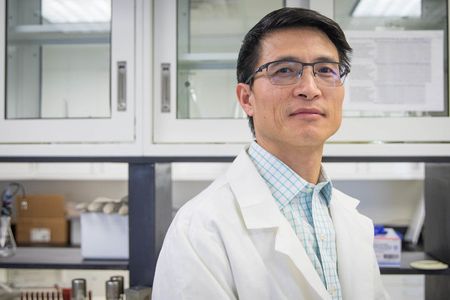
WVU Orthopaedics professor Bingyun Li leads team researching nanotechnology that turns carbon dioxide into baking soda.
MORGANTOWN, W.Va. – Research at West Virginia University will focus on turning carbon dioxide in power plant flue gas into commercial-quality sodium bicarbonate—baking soda—aiming to use product sales to lower the cost of carbon capture technology.
Current techniques can increase the cost of the cleanest coal-fired ultrasupercritical power plants by more than 50 percent, according to data in the annual technology baseline report by the National Renewable Energy Laboratory.
The $1 million project is being funded by the U.S. Department of Energy Office of Fossil Energy through the National Energy Technology Laboratory. The collaborators are providing 20 percent matching funding.
WVU Orthopaedics professor Bingyun Li, a nanomaterials science expert and the project’s leader, will conduct laboratory experiments to test the effects of other gases in power plant flue gas on the process. Along with carbon dioxide, flue gas contains mostly nitrogen, water vapor, and oxygen plus pollutants such as sulfur dioxide and nitrogen oxides.
Jingxin Wang
Chemical engineering professor Badie Morsi of the University of Pittsburgh will develop a commercial-scale system based on the process while WVU Davis College of Agriculture, Natural Resources and Design professor Jingxin Wang will evaluate the process’s costs. Longview Power, LLC, who operates the country’s cleanest coal-fired power plant located in Maidsville, will help create a technology-to-market strategy.
Li’s preliminary studies revealed two amino acids, glycine (Gly) and alanine (Ala), with the ability to capture and convert carbon dioxide into bicarbonate nanofibers or ‘flowers’ of nanowires. Because amino acids are the building blocks of proteins in living things, the process is safe for the environment. The patent-pending process works faster and absorbs three times more carbon dioxide than the current leading post-combustion carbon capture technology, he said.
James Wood, interim director, Energy Institute
“Dr. Li’s unique innovation has the potential to overcome the very high equipment costs of current carbon capture and storage technologies. Having a particularly well-run power plant nearby with strong management interested in working with us is important for gaining the design and installation knowledge needed for commercialization,” said WVU Interim Energy Institute Director James Wood. “This is an excellent example of a university’s ability to foster cross-cutting research and an example of why WVU is an R1 ranked research institution.”
“The release of carbon dioxide from power plants impacts our daily life and also the coal industry. We are very happy to lend our expertise in nanotechnology to solve an important environmental and energy problem, and we are fortunate to be able to support the coal industry in our state and worldwide,” said Li. “We may also explore some new markets for the nano-baking soda we convert from the carbon dioxide.”
Sodium bicarbonate is a 5.7-million-tons-per-year market and growing. Global Market Insights predicts that the market will be worth $9 billion by 2024. The chemical is used in everything from baked goods to cleaning products to pharmaceuticals. The unusual shape of the nano- particles produced by WVU’s patented process opens the possibility for new applications such as the manufacture of encapsulated drugs.
Li observed that solvents produced a never-before-reported clear separation of a CO2-lean phase and a CO2-rich phase, making it easier to separate the baking soda particles from the solvent and recycle the solvent to capture more carbon dioxide and make more particles. The CO2-rich phase contained 73.5 weight percent
sodium bicarbonate, nearly the same as the Solvay process, the current commercial method for making baking soda. Researchers are targeting making a 99.8 percent pure product with the WVU process.
“The WVU technology is simple, with the potential to generate a useful byproduct right at the power plant site,” said Li. “The system that can be retrofitted into existing power plants and added to new power plants.”
–WVU–
tkw/11/14/18
CONTACT: Trina Karolchik Wafle, Deputy Director, National Research Center for Coal and Energy, 304.293.6038, tkwafle@mail.wvu.edu
Follow @WVUToday and @WVUEnergy on Twitter.